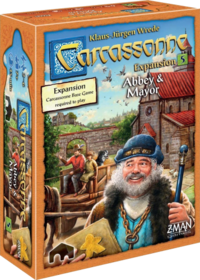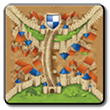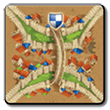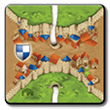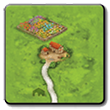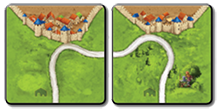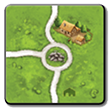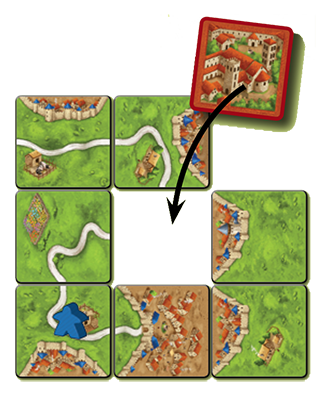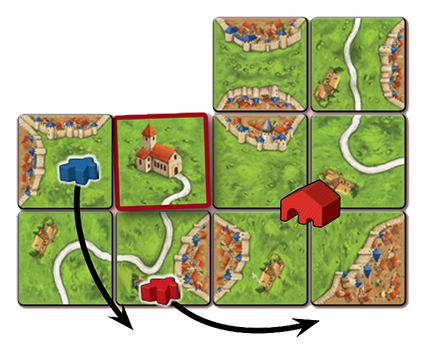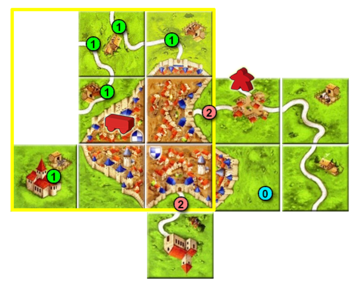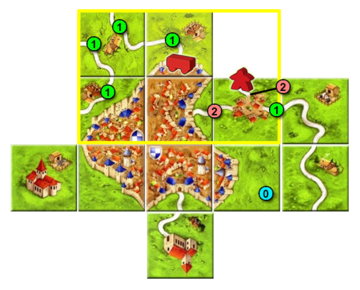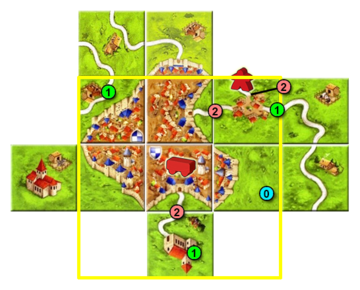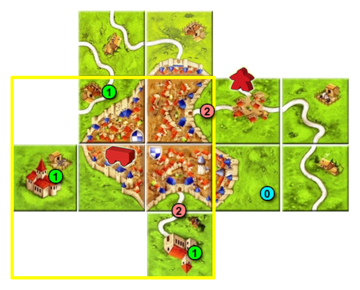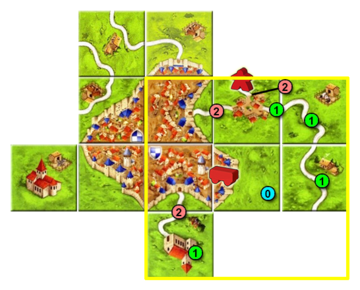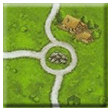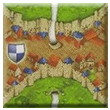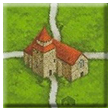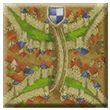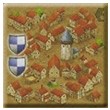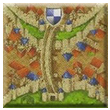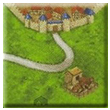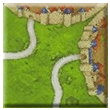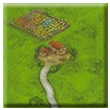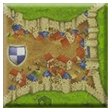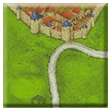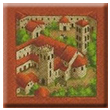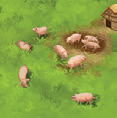Abbey & Mayor
 |
You are reading the rules for this tile design. |
 | Read the following rules if your tiles look like this. |
| If your tiles have a different design, then choose a game from Spin-offs. |  |
General info and comments
Abbey & Mayor was originally released for the New Edition by Hans im Glück in 2016. It was originally released for the 1st Edition (Major Expansion #5) in 2007.
This expansion introduces new tiles including the special abbey tiles, that allow players to close gaps in the game board. It also introduces new figures with special characteristics:
- Mayors, a meeple that can only be placed in cities and has variable strength
- Wagons, a meeple that can move to another feature after scoring
- Barns, a special figure that triggers field scoring during the game
Contents
- 12 new land tiles
- 6 abbey tiles
- 6 mayors
- 6 wagons
- 6 barns
New land tiles
The new Land tiles are played like those in the base game.
Let us explain a few of the new tiles you will find in this expansion:
Rules
Preparation
Each player receives 1 Abbey tile. If you are playing with fewer than 6 players, return the remaining Abbey tiles to the box. Shuffle the new Land tiles with those from the base game (and any other expansions you wish to use). Place them in multiple stacks, as usual. Then give each player the following 3 figures in their color: 1 mayor, 1 wagon, and 1 barn. Each player adds these figures to their regular supply of meeples. [3]
Abbey
1. Placing a tile
If you wish to place an abbey, do not draw a Land tile at the beginning of your turn. Instead of drawing and placing a Land tile, place your Abbey tile. An abbey may only be placed in an empty space surrounded on its 4 orthogonally adjacent sides. In other words, the abbey may only be used to fill a hole. What is depicted on the 4 adjacent tiles (fields, roads, cities) does not matter; the abbey always fits. If no such hole exists, you may not place your abbey.
Note: If one or more players have not placed their abbey when the last landscape tile is drawn and placed, the players will not be able to place them. [4]
2. Placing a meeple
The abbey behaves like a monastery. You may choose to place a meeple as a monk onto your abbey. [5]
3. Scoring a feature
The abbey completes the side of each tile directly adjacent to it. Once you have placed your abbey (and chosen whether or not to place a monk there), score any features completed by its placement. [6]
Scoring the abbey itself, both during a game and at game end, is identical to scoring a monastery.
Mayor
2. Placing a mayor
3. Scoring a feature
The strength of your mayor is equal to the number of coats of arms in the city it occupies. If two or more players have meeples in the same city, it is scored as follows:
- Each normal meeple has 1 strength. [11]
- Each large meeple [12] has 2 strength.
- Each mayor has strength equal to the number of coats of arms in the city. If there are no coats of arms, the mayor has 0 strength.
When scoring a city, each player adds the strength of their meeples in the city. The player with the highest strength scores the points for that city. In case of a tie, all tied players score full points.
The value of a city is not affected by a mayor.
When a city is completed, mayors in that city are returned to their respective supplies.
If a city containing only mayors is completed, but with no coats of arms, each mayor has 0 strength and scores no points for the city.
![]() Question: Blue has a mayor in a city with no coats of arms. Does the city count as occupied? And if so, when the city is scored, will Blue score points?
Question: Blue has a mayor in a city with no coats of arms. Does the city count as occupied? And if so, when the city is scored, will Blue score points?
Answer: The city is occupied. The mayor has no "strength," so it counts as if there is no meeple, and scores no points.
Barn
2. Placing a barn
You may place a barn instead of placing a meeple. [13] If you place a tile that creates a junction where 4 tiles connect to create an open field, you may place your barn directly on that junction. In other words, the corner of each tile forming this junction must only depict a field in order for a barn to be placed there.
You may place your barn on a field already occupied by farmers. You may not, however, place your barn on a field already occupied by another barn. [14] Once placed, a barn remains in play until the end of the game. [15]
3. Scoring a feature
FARMER SCORING AFTER BARN PLACEMENT
If there are farmers in the field where you place your barn, that field is scored immediately, [16] just as it would be at the end of the game. Therefore, the player with the most farmers in that field scores 3 points per completed city in the field. It does not matter which player placed the barn that initiated this scoring.
Then, all farmers occupying that field are returned to their respective supplies.
FARMER SCORING BY FIELD CONNECTION
A field occupied by a barn may NOT be occupied by farmers. If you place a tile that connects a field occupied by one or more farmers to a field occupied by a barn, the connected field is scored during the scoring phase of that turn (after 2. Placing a meeple). The player with the most farmers in that field scores only 1 point per completed city.
Then, all farmers occupying that field are returned to their respective supplies.
Final Scoring
At the end of the game, you score 4 points per completed city in the field your barn occupies. If multiple barns occupy the same field, all concerned players score full points.
Wagon
2. Placing a wagon
3. Scoring a feature
When scoring a feature (road, city, monastery, etc. [18]) a wagon occupies, the wagon is treated like a normal meeple.
After scoring, you may return the wagon to your supply, or you may move it to a directly adjacent unoccupied, incomplete feature (road, city, monastery, etc. [18]). Adjacent, in this case, means that the feature is on the same tile or a tile orthogonally or diagonally adjacent to the tile the wagon is moving from. [19] If there are no such features for your wagon to move to, it must be returned to your supply.
If several wagons are involved in a scoring phase, each concerned player chooses whether to return or move their wagon in clockwise order starting with the active player.
![]() Question: Can you deploy a wagon to a city, score it, and then move the wagon to another feature, all in one turn? Or can you only move the wagon instead of deploying a normal meeple?
Question: Can you deploy a wagon to a city, score it, and then move the wagon to another feature, all in one turn? Or can you only move the wagon instead of deploying a normal meeple?
Answer: The wagon can be deployed instead of a normal meeple. If the city is immediately completed, then it’s scored (wagon or "normal" meeple). After scoring, the wagon can be moved. All of that is possible in a single turn. [Wagon movement is not in place of deployment.]
Additional examples
The wagon can move to any feature except fields. However, the wagon can cross a field to reach an uncompleted unoccupied feature on the same tile where the wagon is placed or on an adjacent tile.
Moving the wagon depends on the location of the wagon within the feature completed and scored. The target feature can be on the same tile or on an adjacent one. Therefore, the wagon can move one tile away at most.
The following examples illustrate the movement of the wagon in various scenarios.
Example 1. Moving from a completed city
After the city is completed and scored, the wagon moves to an adjacent feature which has to be incomplete and unoccupied.
In this case, "adjacent" means a feature on the same tile as the wagon or on a tile orthogonally or diagonally adjacent to it.
This means, the wagon action range is limited because it can only move to the same tile or to any of the tiles on the 8 spaces surrounding it.
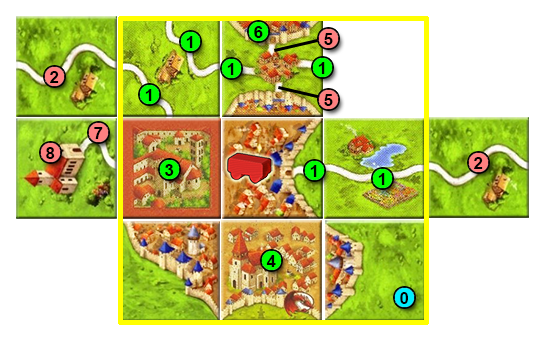
- 0 Tile just placed.
- 1 The wagon can move to any of these road segments on tiles within range because they belong to uncompleted unoccupied features.
- 2 The wagon cannot move to these road segments on tiles out of range even if they belong to uncompleted unoccupied features.
- 3 The wagon can move to this uncompleted unoccupied abbey because it is within range.
- 4 The wagon can move to the uncompleted unoccupied monastery within the city because it is within range.
- 5 The wagon cannot move to any of these short roads.
- 6 The wagon can move to this uncompleted unoccupied city segment within range.
- 7 The wagon cannot move to this road because it is completed and out of range.
- 8 The wagon cannot move to this monastery because it is out of range even if it is uncompleted and unoccupied.
Example 2. Moving from a completed city
After the city is completed and scored, the wagon moves to an adjacent feature which has to be incomplete and unoccupied.
In this case, "adjacent" means a feature on the same tile as the wagon or on a tile orthogonally or diagonally adjacent to it.
This means, the wagon action range is limited because it can only move to the same tile or to any of the tiles on the 8 spaces surrounding it.
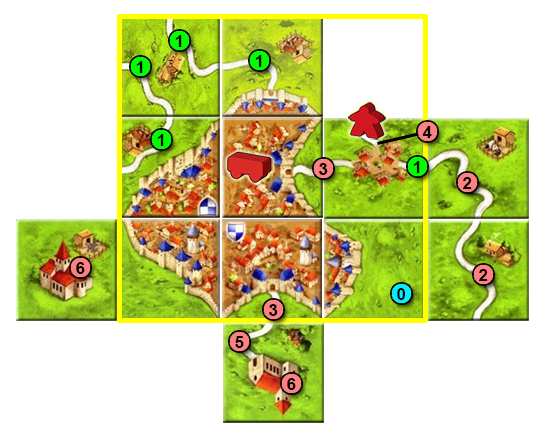
- 0 Tile just placed.
- 1 The wagon can move to any of these road segments on tiles within range because they belong to uncompleted unoccupied roads.
- 2 The wagon cannot move to these road segments on tiles out of range even if they belong to uncompleted unoccupied roads.
- 3 The wagon cannot move to this road segment on a tile within range because the feature is completed.
- 4 The wagon cannot move to this road segment on a tile within range because the feature is uncompleted but occupied.
- 5 The wagon cannot move to this road segment because it is out of range and belongs to a completed feature.
- 6 The wagon cannot move to any of these monasteries because they are out of range although uncompleted and unoccupied.
Depending on the position of the wagon in the city, the action range changes, as shown below.
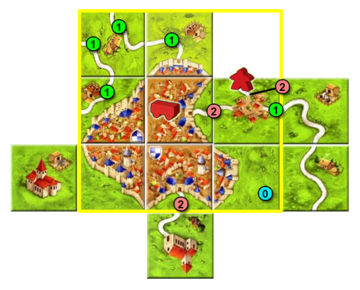
- 0 Tile just placed.
- 1 The wagon can move to any of these road segments on tiles within range because they belong to uncompleted unoccupied features.
- 2 The wagon cannot move to road segments within range on these roads because they belong to completed or occupied features.
Example 3. Moving from a completed road
After the road is completed and scored, the wagon moves to an adjacent feature which has to be incomplete and unoccupied.
In this case, "adjacent" means a feature on the same tile as the wagon or on a tile orthogonally or diagonally adjacent to it.
This means, the wagon action range is limited because it can only move to the same tile or to any of the tiles on the 8 spaces surrounding it.
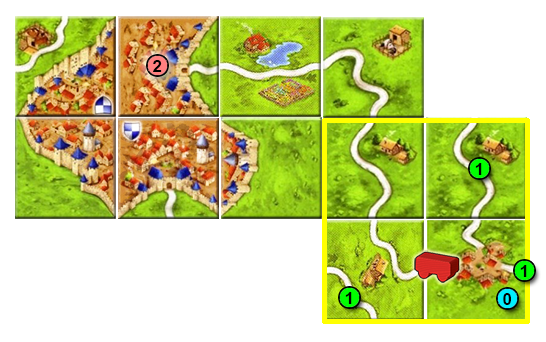
- 0 Tile just placed.
- 1 The wagon can move to any of these tiles within range because they belong to uncompleted unoccupied roads; two of them are connected to the same crossroads closing the road with the wagon and the other is on an orthogonal tile separated by a field.
- 2 The wagon cannot move to this uncompleted unoccupied city closing the road just completed because it is out of range.
Other expansions
This section contains additional information about the interactions with other Carcassonne expansions.
![]() You can occupy an abbey with the following meeples:
You can occupy an abbey with the following meeples:
- Normal meeple (
 Base Game)
Base Game) - Abbot (Base Game -
 The Abbot), since abbeys behave like monasteries.
The Abbot), since abbeys behave like monasteries. - Large meeple (
 Exp. 1 - Inns & Cathedrals)
Exp. 1 - Inns & Cathedrals) - Wagon (
 Exp. 5 - Abbey & Mayor)
Exp. 5 - Abbey & Mayor) - Ringmaster (
 Exp. 10 - Under the Big Top)
Exp. 10 - Under the Big Top) - Guard meeple (
 Exp. 11 - Ghosts, Castles & Cemeteries)
Exp. 11 - Ghosts, Castles & Cemeteries) - Phantom (
 The Phantom)
The Phantom)
![]() If a player completes a feature with an abbey tile and his or her builder is on the feature, the feature does not get “extended” by the abbey (as the abbey is a separate feature), so the player does not get another tile (i.e. no double turn).
If a player completes a feature with an abbey tile and his or her builder is on the feature, the feature does not get “extended” by the abbey (as the abbey is a separate feature), so the player does not get another tile (i.e. no double turn).
![]() Question: If cities with trade goods are completed by placement of an abbey tile, are the goods tokens awarded as usual to the player placing the abbey tile?
Question: If cities with trade goods are completed by placement of an abbey tile, are the goods tokens awarded as usual to the player placing the abbey tile?
Answer: Yes, as the player completed the city.
![]() If a player has an abbey left, draws the very last tile, and plays it to a feature where he or she has a builder, the abbey may be played on the second part of the double-turn.
If a player has an abbey left, draws the very last tile, and plays it to a feature where he or she has a builder, the abbey may be played on the second part of the double-turn.
![]() The rules that restrict the placement of monasteries next to already placed shrines (and vice versa) also restrict the placement of abbeys.
The rules that restrict the placement of monasteries next to already placed shrines (and vice versa) also restrict the placement of abbeys.
![]() A shrine can challenge an abbey, and vice versa, because the abbey is also a monastic building.
A shrine can challenge an abbey, and vice versa, because the abbey is also a monastic building.
![]() Placing an abbey may close a road end but not extend it, so it does not allow a player to move a ferry. [20]
Placing an abbey may close a road end but not extend it, so it does not allow a player to move a ferry. [20]
![]() The Besiegers /
The Besiegers / ![]() The Cathars /
The Cathars / ![]() Siege
Siege
![]() A knight (i.e. meeple) in a besieged city from can escape via an abbey, as it is a monastic building.
A knight (i.e. meeple) in a besieged city from can escape via an abbey, as it is a monastic building.
![]() If you have the majority in a field where a barn is placed, you score 1 additional point per completed city (4 points total) if your pig is in that field. Furthermore, if you have the majority in a field that becomes connected to a field occupied by a barn, you score 1 additional point per completed city (2 points total) if your pig is in that field.
If you have the majority in a field where a barn is placed, you score 1 additional point per completed city (4 points total) if your pig is in that field. Furthermore, if you have the majority in a field that becomes connected to a field occupied by a barn, you score 1 additional point per completed city (2 points total) if your pig is in that field.
![]() You can place your pig on a tile that connects your farmer to a barn. After scoring your pig, return it to your supply.
You can place your pig on a tile that connects your farmer to a barn. After scoring your pig, return it to your supply.
![]() Question: May the pig be placed in a field that was just connected to a field with a barn, i.e. on the newly placed tile (immediately before scoring)?
Question: May the pig be placed in a field that was just connected to a field with a barn, i.e. on the newly placed tile (immediately before scoring)?
Answer: Yes, the pig may be placed in already occupied features [and phase 2. Placing a meeple still happens normally].
![]() Exp. 3 - The Princess & the Dragon
Exp. 3 - The Princess & the Dragon
![]() A barn may not be eaten by the dragon.
A barn may not be eaten by the dragon.
![]() A barn may be placed on a tile with a volcano.
A barn may be placed on a tile with a volcano.
![]() You may not place the fairy by a barn, as the barn is not a meeple.
You may not place the fairy by a barn, as the barn is not a meeple.
![]() A barn may not be placed using a magic portal.
A barn may not be placed using a magic portal.
![]() A barn may not be captured by a tower.
A barn may not be captured by a tower.
![]() You may not place your barn on a tower.
You may not place your barn on a tower.
![]() You can move meeples from the cathedral district to an abbey, as an abbey has all of the characteristics of a monastery.
You can move meeples from the cathedral district to an abbey, as an abbey has all of the characteristics of a monastery.
![]() The city of Carcassonne counts as a city when scoring a barn.
The city of Carcassonne counts as a city when scoring a barn.
![]() The barn cannot be placed in the city of Carcassonne.
The barn cannot be placed in the city of Carcassonne.
![]() If your barn placement or field connection triggers a field scoring in which you score no points, you may place a meeple in the city of Carcassonne.
If your barn placement or field connection triggers a field scoring in which you score no points, you may place a meeple in the city of Carcassonne.
![]() Question: If I place a barn on a field on which another player has farmers, causing him/her to score while I score nothing, can I move a meeple to the city of Carcassonne?
Question: If I place a barn on a field on which another player has farmers, causing him/her to score while I score nothing, can I move a meeple to the city of Carcassonne?
Answer: Yes, that's allowed. Only immediately scored points matter. It doesn't matter that the barn is certain to score at the end of the game.
![]() If a barn placement or field connection triggers a field scoring, you may move meeples from the market in the city of Carcassonne to that field. Score that field as normal, and return all farmers in that field to their respective supplies. (It doesn't matter that the barn is certain to score at the end of the game.)
If a barn placement or field connection triggers a field scoring, you may move meeples from the market in the city of Carcassonne to that field. Score that field as normal, and return all farmers in that field to their respective supplies. (It doesn't matter that the barn is certain to score at the end of the game.)
![]() Question: Are the meeples in the market district only used at the end of the game?
Question: Are the meeples in the market district only used at the end of the game?
Answer: This is no longer entirely true. Placing of a barn, and the subsequent scoring of the field, does count as an opportunity to remove a meeple from the city of Carcassonne. Now that fields can be scored at times other than at the end of the game, meeples from the market can be moved to fields earlier in the game. That occurs immediately after the placement of the barn, and before the fields are scored. [Joining of a field containing a meeple to a field with a barn would logically be another opportunity – Chris O.]
![]() You can move meeples from the market district to a field with a barn (and score it) if a field scoring is triggered. (This can happen at the end of the game or with joining of a barnless field to one with a barn.)
You can move meeples from the market district to a field with a barn (and score it) if a field scoring is triggered. (This can happen at the end of the game or with joining of a barnless field to one with a barn.)
![]() Question: Can a meeple be moved from the city of Carcassonne to a field with a barn?
Question: Can a meeple be moved from the city of Carcassonne to a field with a barn?
Answer: Yes, the farmer will be scored immediately, and so scores only 1 point per city and is (importantly) not on the field during the final scoring proper. [Obviously, placement of a meeple in this manner still requires a scoring trigger as per the fundamental rules – this could be at the end of the game or with joining of a barnless field to one with a barn – Chris O.]
![]() The pig-herd [21] (The River II expansion) only affects field scoring for farmers. Barns do not score additional points from the pig-herd.
The pig-herd [21] (The River II expansion) only affects field scoring for farmers. Barns do not score additional points from the pig-herd.
![]() Exp. 8 - Bridges, Castles & Bazaars
Exp. 8 - Bridges, Castles & Bazaars
![]() When scoring a field, whether for farmers or barns, castles are worth 1 more point.
When scoring a field, whether for farmers or barns, castles are worth 1 more point.
![]() Exp. 11 - Ghosts, Castles & Cemeteries
Exp. 11 - Ghosts, Castles & Cemeteries
![]() The barn cannot be placed at an intersection with mist banks, since they separate fields.
The barn cannot be placed at an intersection with mist banks, since they separate fields.
![]() The Besiegers /
The Besiegers / ![]() The Cathars /
The Cathars / ![]() Siege
Siege
![]() A besieged city scores double points if it lies on a field with a barn.
A besieged city scores double points if it lies on a field with a barn.
![]() The city of Leipzig counts as a city when scoring a barn.
The city of Leipzig counts as a city when scoring a barn.
![]() The barn can be removed by a Festival tile, before the end of the game. (12/2014)
The barn can be removed by a Festival tile, before the end of the game. (12/2014)
Scoring summary
Scoring fields with a barn
1. Scoring a field when placing a barn
If farmer majority –
- 3 points per completed city adjacent to field
- 4 points per castle adjacent to field
- (+1) point per castle or completed city with pig (then return pig to owner's supply)
- (+1) point per castle or completed city with pig-herd tile [21]
- (x2) if besieged city
2. Scoring a connected field
If farmer majority –
- 1 point per completed city adjacent to field
- 2 points per castle adjacent to field
- (+1) point per castle or completed city with pig (then return pig to owner's supply)
- (+1) point per castle or completed city with pig-herd tile
- (x2) if besieged city
Scoring the barn
- 4 point per completed city adjacent to field
- 5 points per castle adjacent to field
- (+0) points per castle or completed city with pig-herd tile (the pig-herd has no effect on barns)
- (x2) if besieged city
![]() Exp. 3 - The Princess & the Dragon
Exp. 3 - The Princess & the Dragon
![]() Both figures may be placed using the magic portal. They may only be placed in features in which they may normally be placed.
Both figures may be placed using the magic portal. They may only be placed in features in which they may normally be placed.
![]() Both figures may be eaten by the dragon.
Both figures may be eaten by the dragon.
![]() Both figures may be seduced by a princess.
Both figures may be seduced by a princess.
![]() Both figures may be captured by the tower.
Both figures may be captured by the tower.
![]() Both figures may not be placed on a tower.
Both figures may not be placed on a tower.
![]() Both figures may be placed in the city of Carcassonne with the following exceptions:
Both figures may be placed in the city of Carcassonne with the following exceptions:
- The mayor may only be placed in the castle quarter.
- The wagon may be placed anywhere but in the market.
 After a wagon is deployed from the city of Carcassonne to a completed feature, it could be moved to an adjacent uncompleted, unoccupied feature after scoring as usual, if any available.
After a wagon is deployed from the city of Carcassonne to a completed feature, it could be moved to an adjacent uncompleted, unoccupied feature after scoring as usual, if any available.
![]() Exp. 8 - Bridges, Castles & Bazaars
Exp. 8 - Bridges, Castles & Bazaars
![]() Both figures may occupy a castle. However, the mayor (now the lord of this castle) cannot score points for that castle, as that castle does not have any coats of arms.
Both figures may occupy a castle. However, the mayor (now the lord of this castle) cannot score points for that castle, as that castle does not have any coats of arms.
![]() A wagon placed in castle can move to valid feature in the castle fief after scoring.
A wagon placed in castle can move to valid feature in the castle fief after scoring.
![]() Question: Can a wagon placed in a castle move to a neighboring unoccupied feature after scoring?
Question: Can a wagon placed in a castle move to a neighboring unoccupied feature after scoring?
Answer: Yes, the wagon can move to a neighboring unoccupied feature after scoring. (2/2021)
![]() The mayor can be a flier. However, the mayor can only land on an unfinished city. If an unfinished city is not available on the tile where the mayor lands, the mayor returns to the player’s supply. (2/2013)
The mayor can be a flier. However, the mayor can only land on an unfinished city. If an unfinished city is not available on the tile where the mayor lands, the mayor returns to the player’s supply. (2/2013)
![]() The Besiegers /
The Besiegers / ![]() The Cathars /
The Cathars / ![]() Siege
Siege
![]() Both figures, if placed in a besieged city, can escape via a monastery or any equivalent feature, such as an abbey (although it would be quite amusing if the mayor stayed, like a captain going down with the ship.)
Both figures, if placed in a besieged city, can escape via a monastery or any equivalent feature, such as an abbey (although it would be quite amusing if the mayor stayed, like a captain going down with the ship.)
New tiles
House Rules
![]() The wagon can move to the next complete, or uncontested and incomplete, feature. This lets it roll across the board to uncontested features. (Thanks to viberunner)
The wagon can move to the next complete, or uncontested and incomplete, feature. This lets it roll across the board to uncontested features. (Thanks to viberunner)
![]() The mayor cannot be captured by the tower. (Thanks to viberunner)
The mayor cannot be captured by the tower. (Thanks to viberunner)
![]() The wagon cannot be eaten by the dragon or captured by the tower. (Thanks to viberunner)
The wagon cannot be eaten by the dragon or captured by the tower. (Thanks to viberunner)
![]() The mayor is laid flat in the same way as farmers so that you can tell at a glance which cities contain mayors. (Thanks to Joff)
The mayor is laid flat in the same way as farmers so that you can tell at a glance which cities contain mayors. (Thanks to Joff)
![]() The pig-herd [21] tile can score an extra point per city when there is a barn in the field.
The pig-herd [21] tile can score an extra point per city when there is a barn in the field.
Tile distribution
Footnotes
For Icons explanation and licensing please visit Icons page.
- ↑
 The road with a tunnel does indeed count as being “broken” if one is using the
The road with a tunnel does indeed count as being “broken” if one is using the  The Tunnel expansion from the 1st Edition. See Other expansions for more details.
The Tunnel expansion from the 1st Edition. See Other expansions for more details.
- ↑
 All of the branches have to be completed in order to score the road scoring. See Other expansions for more details on the interaction with the Robber tile from
All of the branches have to be completed in order to score the road scoring. See Other expansions for more details on the interaction with the Robber tile from  Exp. 6 - Count, King & Robber.
Exp. 6 - Count, King & Robber.
- ↑
 Official status: The mayor and wagon are meeples, subject to the usual rules of deployment and affecting the majority. The barn is a special figure, not a meeple.
Official status: The mayor and wagon are meeples, subject to the usual rules of deployment and affecting the majority. The barn is a special figure, not a meeple.
- ↑
 This paragraph was not included in the original rules but has been added for the sake of clarity, since the rules in this regard have changed since the First Edition.
This paragraph was not included in the original rules but has been added for the sake of clarity, since the rules in this regard have changed since the First Edition.
 Question: The rules in Big Box 2 and Big Box 3, included the following action regarding the remaining abbeys at the end of the game:
Question: The rules in Big Box 2 and Big Box 3, included the following action regarding the remaining abbeys at the end of the game:
"If one or more players have not yet placed their Abbey tiles when the last landscape tile is drawn and placed, they may now do so, if possible, in clockwise order starting from the left of the person who placed the last tile. Then, the game ends."
Does this extra round with abbey tiles still apply?Answer: No, this extra rule does not apply anymore. (2/2021)
This rule wasn't part of the original wording but was added in HiG’s and RGG’s
 Big Box 2 (and kept in
Big Box 2 (and kept in  Big Box 3), and actually contradicted an earlier FAQ (which stated that the abbey tiles couldn't be placed once the last landscape tile was drawn). It was not included in the New Edition rules either, so a clarification was required.
Big Box 3), and actually contradicted an earlier FAQ (which stated that the abbey tiles couldn't be placed once the last landscape tile was drawn). It was not included in the New Edition rules either, so a clarification was required.
As a side note, when an abbey was played in this manner in the Old Edition, a meeple could be deployed to the abbey as usual. If the abbey was completely surrounded and thus immediately finished, the abbey was scored as in a normal turn. Then final scoring occurred. (5/2013) - ↑
 When an abbey tile is placed, a meeple cannot be deployed next to the abbey (as a knight, for example), as the abbey covers the whole tile. The surroundings are not a city. Thus, a meeple on this tile is a monk.
When an abbey tile is placed, a meeple cannot be deployed next to the abbey (as a knight, for example), as the abbey covers the whole tile. The surroundings are not a city. Thus, a meeple on this tile is a monk.
- ↑
 Abbeys can close cities and roads but they are not part of the feature itself. Bear this in mind when scoring cities completed by abbeys and also when scoring fields.
Abbeys can close cities and roads but they are not part of the feature itself. Bear this in mind when scoring cities completed by abbeys and also when scoring fields.
For example: Let's assume a city closed by an abbey and a neighboring field that only has a common boundary with the abbey tile. In this case, the field will get no points from that city, as it is not in direct contact with it. - ↑
 Note that the mayor is also a meeple. The original rules use the word "meeple" but meaning "normal meeple", as if considering the expansion being played with the base game alone. This sentence was updated accordingly to broaden the reference to any meeples.
Note that the mayor is also a meeple. The original rules use the word "meeple" but meaning "normal meeple", as if considering the expansion being played with the base game alone. This sentence was updated accordingly to broaden the reference to any meeples.
- ↑
 Any meeple, including the mayor, that is placed in a city is considered to be a knight.
Any meeple, including the mayor, that is placed in a city is considered to be a knight.
- ↑
 This sentence was updated. The original wording may lead to the interpretation that mayors placed in a city are not knights: "A mayor may only be placed in a city containing no knights or mayors."
This sentence was updated. The original wording may lead to the interpretation that mayors placed in a city are not knights: "A mayor may only be placed in a city containing no knights or mayors."
- ↑
 The mayor cannot be placed into a city that already contains a wagon. Both are meeples (according to the definition in the rules), so the city is already occupied by the wagon.
The mayor cannot be placed into a city that already contains a wagon. Both are meeples (according to the definition in the rules), so the city is already occupied by the wagon.
- ↑
 Except the large meeple and the mayor, all other meeples not mentioned here have 1 strength, the same as the normal meeple: the wagon, the ringmaster (
Except the large meeple and the mayor, all other meeples not mentioned here have 1 strength, the same as the normal meeple: the wagon, the ringmaster ( Exp. 10 - Under the Big Top), the guard meeple (
Exp. 10 - Under the Big Top), the guard meeple ( Exp. 11 - Ghosts, Castles & Cemeteries),and the phantom (
Exp. 11 - Ghosts, Castles & Cemeteries),and the phantom ( The Phantom).
The Phantom).
- ↑
 A meeple introduced in
A meeple introduced in  Exp. 1 - Inns & Cathedrals.
Exp. 1 - Inns & Cathedrals.
- ↑
 The barn is not a meeple.
The barn is not a meeple.
- ↑
 Fields with barns can be joined resulting in fields with more than one barn.
Fields with barns can be joined resulting in fields with more than one barn.
- ↑
 The barn can, however, be removed by a Festival tile. See Other expansions for more details.
The barn can, however, be removed by a Festival tile. See Other expansions for more details.
- ↑
 The word "immediately" here means that farmers are scored then removed during the normal scoring phase of this turn (as opposed to staying on the field until the end of the game). The placement of a barn does not stop play for a separate scoring phase for the farmers. Thus, the normal “move wood” portion of the turn occurs before the farmers are scored. (10/2012)
The word "immediately" here means that farmers are scored then removed during the normal scoring phase of this turn (as opposed to staying on the field until the end of the game). The placement of a barn does not stop play for a separate scoring phase for the farmers. Thus, the normal “move wood” portion of the turn occurs before the farmers are scored. (10/2012)
- ↑
 Note that the wagon is also a meeple. The rules use the word "meeple" but meaning "normal meeple", as if considering the expansion being played with the base game alone.
Note that the wagon is also a meeple. The rules use the word "meeple" but meaning "normal meeple", as if considering the expansion being played with the base game alone.
- ↑ 18.0 18.1 18.2
 This feature list should be extended to cover all claimable features available except fields and gardens (only valid for abbot meeples):
This feature list should be extended to cover all claimable features available except fields and gardens (only valid for abbot meeples):
- Road
- City
- Monastic buildings:
- Monastery
- Abbey
- Shrine
- German monastery (placed as a monk or as an abbot)
- Dutch & Belgian monastery (placed as a monk or as an abbot)
- Japanese building (placed as a monk or as an abbot)
- Darmstadt Church
- Cemetery
- Haunted Castle
- Baba Yaga’s Hut
- German Castle
- German Cathedral
- ↑
 The wagon rules in
The wagon rules in  Exp. 5 - Abbey & Mayor were different in the following aspects:
Exp. 5 - Abbey & Mayor were different in the following aspects:
- Adjacency: The wagon could only move to an unoccupied, incomplete feature connected by a road or sharing a surface/edge/wall:
- Cases allowed:
- Road to road through a crossing
- Road to any claimable feature and vice versa: city (through a gate), monastery (or equivalent feature such as an abbey), etc.
- A city to an adjacent abbey and vice versa
- A city to a monastery within and vice versa
- Cases not allowed:
- Two cities with touching walls or tips on the same or on different tiles.
- Two cities connected by "small roads" where meeples cannot be placed.
- Two cities crossing via bridges but no connected via roads.
- Two roads separated by a feature (any area on a tile that can be claimed by a meeple or that triggers a function)
- A road touching a city wall with no gate
- A road running through a city via a tunnel or passing over via a bridge
- Cases allowed:
- Placement: the wagon could be placed on any tile of the chosen unoccupied, incomplete feature.
- Adjacency: The wagon could only move to an unoccupied, incomplete feature connected by a road or sharing a surface/edge/wall:
- ↑
 This clarification follows the same logic as the interaction of the abbey and the builder.
This clarification follows the same logic as the interaction of the abbey and the builder.
- ↑ 21.0 21.1 21.2
 The English rules called this feature "pigsty." We use pig-herd for consistency with Carcassonne I and also in order to avoid the confusion with the pigsty feature introduced in Carcassonne II, scored by some expansions such as
The English rules called this feature "pigsty." We use pig-herd for consistency with Carcassonne I and also in order to avoid the confusion with the pigsty feature introduced in Carcassonne II, scored by some expansions such as  The Markets of Leipzig or
The Markets of Leipzig or  The Tollkeepers.
The Tollkeepers.
